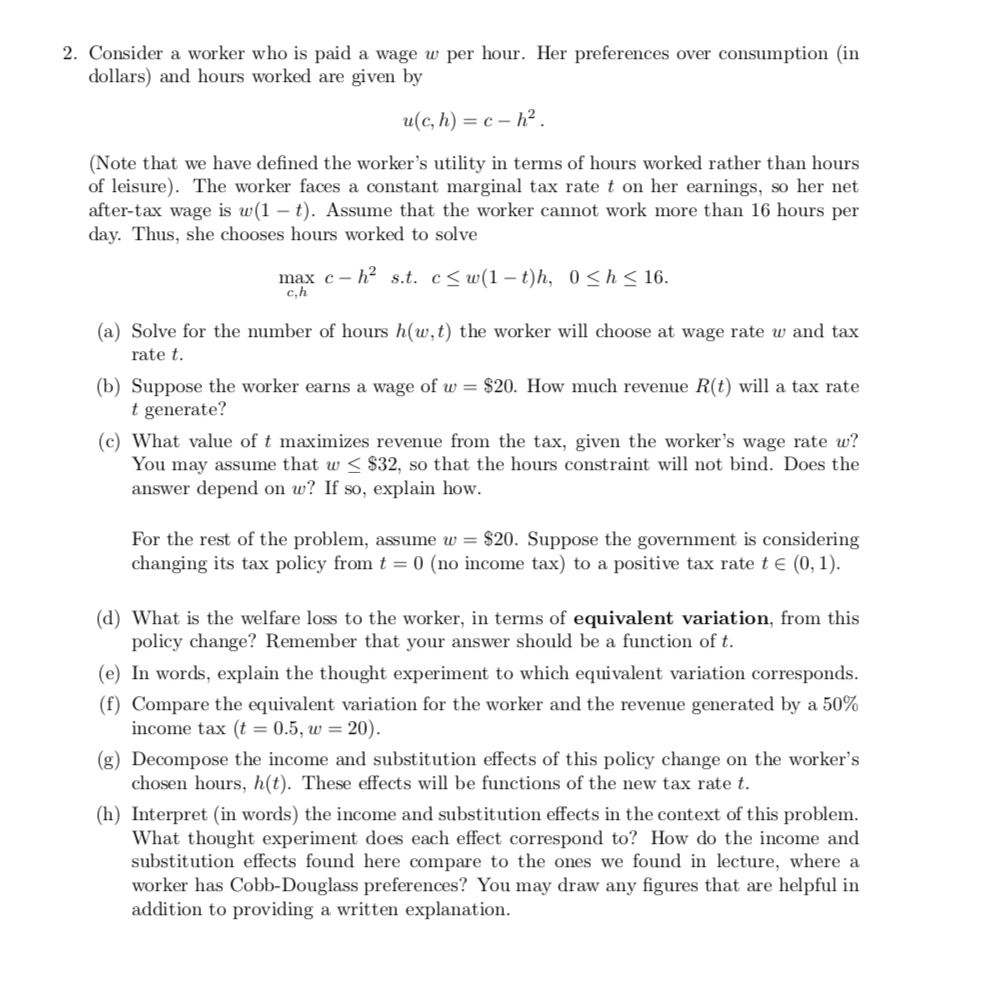Answered step by step
Verified Expert Solution
Question
1 Approved Answer
2. Consider a worker who is paid a wage w per hour. Her preferences over consumption (in dollars) and hours worked are given by

2. Consider a worker who is paid a wage w per hour. Her preferences over consumption (in dollars) and hours worked are given by u(c, h)=c-h. (Note that we have defined the worker's utility in terms of hours worked rather than hours of leisure). The worker faces a constant marginal tax rate t on her earnings, so her net after-tax wage is w(1 t). Assume that the worker cannot work more than 16 hours per day. Thus, she chooses hours worked to solve max ch s.t. cw(1-t)h, 0h 16. c,h (a) Solve for the number of hours h(w,t) the worker will choose at wage rate w and tax rate t. (b) Suppose the worker earns a wage of w = $20. How much revenue R(t) will a tax rate t generate? (c) What value of t maximizes revenue from the tax, given the worker's wage rate w? You may assume that w < $32, so that the hours constraint will not bind. Does the answer depend on w? If so, explain how. For the rest of the problem, assume w = $20. Suppose the government is considering changing its tax policy from t = 0 (no income tax) to a positive tax rate t (0, 1). (d) What is the welfare loss to the worker, in terms of equivalent variation, from this policy change? Remember that your answer should be a function of t. (e) In words, explain the thought experiment to which equivalent variation corresponds. (f) Compare the equivalent variation for the worker and the revenue generated by a 50% income tax (t = 0.5, w = 20). (g) Decompose the income and substitution effects of this policy change on the worker's chosen hours, h(t). These effects will be functions of the new tax rate t. (h) Interpret (in words) the income and substitution effects in the context of this problem. What thought experiment does each effect correspond to? How do the income and substitution effects found here compare to the ones we found in lecture, where a worker has Cobb-Douglass preferences? You may draw any figures that are helpful in addition to providing a written explanation.
Step by Step Solution
★★★★★
3.54 Rating (147 Votes )
There are 3 Steps involved in it
Step: 1
ANSWERS a hw t w1t b Rt tw wt c t 1 d EVt tw wt e The thought experiment to which equivalent variation corresponds is the following imagine that the w...
Get Instant Access to Expert-Tailored Solutions
See step-by-step solutions with expert insights and AI powered tools for academic success
Step: 2

Step: 3

Ace Your Homework with AI
Get the answers you need in no time with our AI-driven, step-by-step assistance
Get Started


